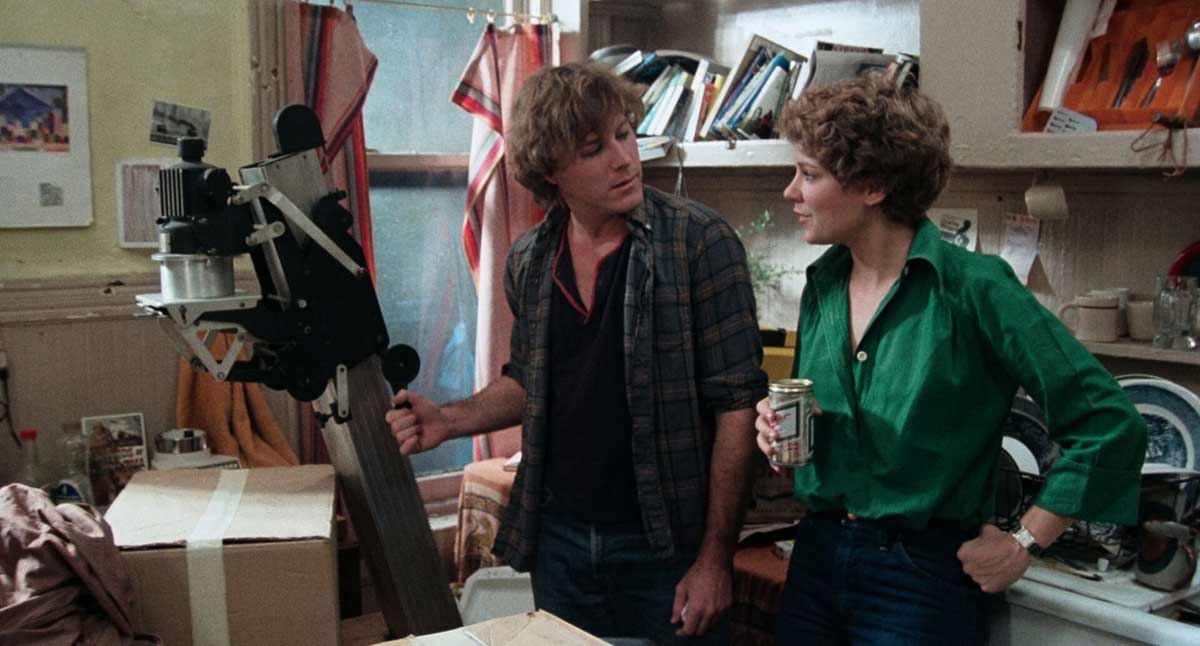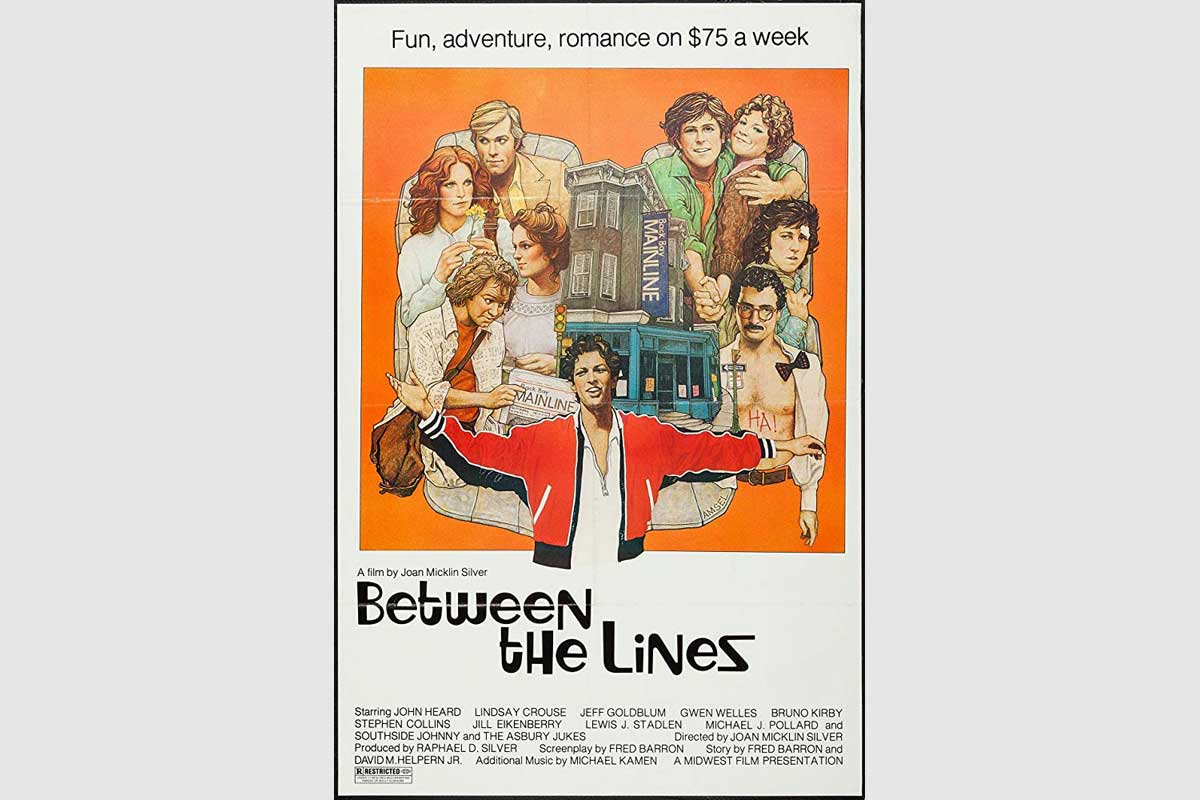Less than 15 minutes into the opening of Joan Micklin Silver’s sophomore feature Between the Lines, John Heard’s character Harry Lucas, a hypochondriacal and cynically inert reporter for the fictional alternative weekly the Mainline, utters a sentence that not only sums up his mixed emotions about his legacy at the paper, but may well also in hindsight encapsulate the feelings of any creative soul of that time, and perhaps the very paradox of the ‘70s themselves.
“We really shook things up, y’know… we didn’t change anything.”

As a primary directive of a newspaper is to inform the public and expand their knowledge, the subject matter of Between the Lines was well-suited to Silver. Upon graduating college, she first worked as a teacher while writing plays, and in the early ‘70s, freelanced for one of the most famous alternative newspapers, the Village Voice. During that period, Silver struck up a valuable collaborative friendship with producer Linda Gottlieb, then serving as vice president of Encyclopaedia Britannica’s film division, who hired her to script their educational films. Silver’s research into the lives of women involved with Vietnam soldiers either missing in action or being held prisoner was serialized for McCall’s magazine, and became the material of her first produced screenplay, Limbo, which was made by Universal in 1972 with Gottlieb as producer and Mark Robson as director. Despite being fired from the project over her opposition to a rewrite, Silver was still invited to the shoot by Robson to observe the production. When Gottlieb left Britannica for another leading educational film studio, Learning Corporation of America, Silver was enlisted to direct projects for the company. One of those shorts, The Immigrant Experience, a dramatization of a Polish family emigrating to America intended for high school students, not only won several awards, but effectively served as a catalyst for Silver’s breakout debut feature, Hester Street, an adaptation of Abraham Cahan’s 1897 novel Yekl: A Tale of the New York Ghetto. It was during promotional appearances for Hester Street when Silver and her producer / husband Raphael met Fred Barron, then a writer for the Boston alternative weekly Real Paper, who pitched them a story created with David Helpern Jr., a documentarian and professor at The Film School in Cambridge, titled Fun While it Lasted, based on his experiences at the publication, initially intended for Helpern to direct. In an interview for the DGA with director Michael Pressman, she elaborated on her embrace of the material:
“[The] way it came about was, when we went to Cannes, we met a reporter from an independent newspaper… he told me that he’d written a screenplay, and he would like me to read it. And I read it, and I really loved it, and I especially loved two scenes in it, I thought they were fabulous, and I thought I’ve gotta make this. I love this group of people, and I had worked at The Village Voice… I’d always read the independent press with so much interest, but what it’s really about is the co-opting of an independent press, as was happening by big companies who were buying them up, and all the stuff that was happening with the young people… [After] Hester Street, I was brought to California, and you know, met [studio people], and they said, ‘We wanna make the next thing you wanna make, what do you wanna make?’ And I said, ‘Well, Between the Lines, this is the one that I have,’ and they didn’t wanna make it. So [my husband] Ray said, ‘Let’s take our share of the profits of Hester Street and let’s make it.’… [We] went up [to Boston] with the actors, I think a week before… we did improvs, we did all sorts of things, and I scripted about a third of the movie [out] of their improvs. And I would listen to them and script them at night and give them the script pages, and they would learn them.”

The filming of Lines was a harmonious, albeit tightly-budgeted production. Initial preproduction and two weeks of filming took place in Boston, but due to costs associated with the location, the remainder of the shooting took place in New York. To prepare for his role, Bruno Kirby spent weeks at a west coast paper, the L.A. Free Press, working in the classified department; despite having already appeared in The Godfather Part II and Baby Blue Marine, he went unrecognized by their staff. For a pivotal scene involving a record release party, Silver recounted to Pressman, “One of the nice things that happened was Southside Johnny and the Asbury Jukes, [Robert] Christgau at The Village Voice had suggested them. And we went down to Asbury Park to see Southside Johnny. It was like a garage band, and he was wonderful. And all of a sudden this wonderful person comes in and plays with them, and I thought, wow, what an attractive person, you know, I wish we could get him. Of course it turned out to be Bruce Springsteen. I didn’t recognize him, but he was a friend of Southside Johnny’s and wanted to help him get the gig.”
Between the Lines spends several days among the staff of Boston’s Back Bay Mainline, all of whom have a co-dependent relationship to the publication, and some of whom have co-dependent relationships with each other. The aforementioned Harry has been coasting on his reputation, turning in less substantial stories than before, and vainly trying to woo back his ex Abbie (Lindsay Crouse), the staff photographer, who still seems to possess some fire about her job. Motormouthed rock critc Max (Jeff Goldblum) lives on the dwindling cache of being able to publish his opinions, since the meager $75 a week he earns for his position means he’s selling off his promo records and dining out on his self-proclaimed musicology. Michael (Stephen Collins), another previous golden boy, has all but left the paper to write a novel about “the sixties” and seems to show up only to crow about his imminent departure, while his well-heeled girlfriend and founding staff writer Laura (Gwen Welles) pays the bills and finds needed friendship at the office during his neglect. David (Bruno Kirby), the put-upon classifieds director, yearns to become a reporter in the vein of Harry and Michael, even though they don’t take him seriously. The paper’s resident street hawker (Michael J. Pollard) is literally a resident, sleeping at the office in exchange for eagerly walking the streets each week. Lynn (Jill Eikenberry), the receptionist, feels envious of the other women at the office, not understanding her skill set required to be the first person callers and visitors encounter when contacting the publication she respects. Stanley (Lewis J. Stadlen), the advertising director, conducts himself as if he is the only person keeping the publication alive, his disdain for the writers is reciprocated in abundance. All these disparate personalities have figured out how to co-exist, but as word spreads that a deep-pocketed buyer is circling the paper, long-standing issues among them all will force a reckoning.
As Harry’s lament would predict, Lines would meet with positive reception, but little actual impact, in its theatrical release. When it premiered at the Berlin International Film Festival in June 1977, Silver won two prizes – the Interfilm Otto Dibelius Film Award, and the Reader Jury of the “Berliner Morgenpost” Award – and the film was nominated for the Golden Bear, ultimately won by The Ascent from the Soviet Union. In America, as with Hester Street, the Silvers spent the summer self-distributing the movie with assistance from consultant Jeff Lipsky, who had previously worked with John Cassavetes on his self-released films, and later co-founded October Films with Bingham Ray. In an interview that year with John A. Gallagher for the book Film Directors on Directing, she was cautiously optimistic, saying, “We’ve succeeded in getting some very good houses… we started distribution and then we had to taper off a little because all these big summer films came out… You have to wait for some of those films to ‘fall out of bed,’ as they say, and then you can move in because exhibitors are looking for product again.” In the later DGA interview, she recalled, “[By] that time, just in that short period of time it was much harder to do, and we couldn’t afford the ads in the paper, which was where people were [learning about new releases] – they were huge, you know, and they had to be. And it wasn’t about a theme like Hester Street that already had a niche audience, as they say now.” At the end of the year, Silver and the film won the New Generation Award from the Los Angeles Film Critics Association. Lines likely found its widest audience when it, along with Hester Street, were part of the first wave of titles released by legendary independent home video company Vestron Video.
Over the years since its release, many polarizing opinions, mostly from male critics, have been raised on the movie’s depiction of the male protagonists. Aside from the nebbishy David and the mysterious Hawker, the male staffers’ regard of women pushes the needle past clueless and into full-bore shabby. Max shamelessly uses a lecture spot offered him by a women’s college to ramble pseudo-literate about The Beatles and drop his phone number. When Harry and Abbie interview a stripper (Marilu Henner) for an article, Abbie, who clearly has a better rapport with the performer, gets bigfooted by Harry, whose questions are cliched. Michael pulls cultural rank on Laura despite her being the breadwinner, and automatically assumes that when his opportunity comes, she will drop her work and move with him. In a scene especially chilling in today’s present, Lynn is stuck politely listening to Stanley mansplain away an earlier “misunderstanding” between them before she, without raising her voice, flatly tells him, “You jumped on top of me.” Every ‘70s Movie blogger Peter Hanson wrote in 2014, “[Most] of the male characters are schmucks who treat women terribly. This accurately reflects the time period being depicted – the ’70s were lousy with studs who shrouded macho egotism behind sensitive-guy posturing – but it’s not much fun to watch dudes demean the ladies in their lives.” More recently, Jonathan Romney wrote for Film Comment, “What’s a little shocking about the film now, although it’s no doubt what makes it true to life, is the almost aristocratic narcissism that defines many of the male characters, who are hugely intolerant of people they consider less talented, or less cool, or less good-looking then themselves. It’s profoundly uncomfortable to see Harry’s lofty contempt when casually dismantling a piece [that] David has submitted for his advice…” While it is tempting to attribute these elements to Silver, these themes were likely already in the script that Barron, the sole credited screenwriter, first proffered to her.

The fact that the film does not completely damn any of these characters, by comparison, is a direct choice made by Silver, and it is a recurrent notion in her films. Hester Street, which starts by depicting the end of a marriage brought down by a cultural divide, resolves itself with each of its former spouses finding happiness with new partners who are a better match. In her later film Stepkids (released under the ill-conceived “commercial” title Big Girls Don’t Cry… They Get Even), a young girl annoyed by the stress of navigating the internecine feuds of her extended blended family gains perspective on her situation by running away, while, in her absence, the warring half-siblings and substitute parents in turn take a pause on their grievances. In her 1977 book interview, Silver observed, “I think that people express in films their own personalities. It may be a function of my age or the way I was raised, but I don’t have nearly as depressed or pessimistic a view of human beings as some people do. It may have something to do with the era I grew up in. Somebody said to me about Between the Lines that I was too nice to the characters. I said, ‘What do you mean?’ They said, ‘You end up liking them all, even the awful ones.’ I don’t think that’s a criticism. I think that’s pretty nice. I tend to see people as a mix, you know, the Jewish view is that people have the potential for good and evil and I really agree.”
Silver’s expansive capacity for hope is what significantly prevents the finish of the story from being neither unbearably and predictably bleak nor ridiculously saccharine. Some people will indeed leave the paper by various means, and not always the right reasons. But from this upheaval of the status quo, there is potential for better things. Newer correspondents not yet thwarted by Sisyphean challenges. Burned-out creatives forced out of their comfort zone, finding excitement in that next chapter, and in turn, not having to lean on others to find validation. The loathsome Stanley, earlier threatened with physical retaliation for his attitude, getting his just desserts, though in Silver’s world, better served directly from Hashem rather than one of the other posturing men on staff. And for some, having another moment or two when a stranger tells them what they did mattered. The news keeps on happening.
Looking over the macrocosm of time since the making of Lines, the first impulse is to agree with Harry’s conundrum over having broken through convention for a short while yet ultimately not making lasting impact. Consider that the end of the movie has a credit reading, “Special thanks to the Real Paper, the Boston Phoenix, the Los Angeles Free Press, the Soho Weekly News, and the Village Voice,” and of these publications, only the Voice survives, and only as a website, ending its print edition in 2017. For the filmmaking cliques of the ‘70s that emerged, hoping to displace formula films with more unique creations, the ascension of event pictures, some directed by those very rulebreakers, may have left them feeling that sense of futility, that the circus will always dominate over the shadow play. For anyone who witnessed the advances in creating parity for women and marginalized communities and thoughtful world engagement taking place during the film’s setting, which now seem to be daily rolled back violently by strident forces of tribalism and ossified political narcissism, it must be exponentially depressing to see the promise dissipated. And thus it is understandably difficult to stave off feelings of uselessness and enervation.
But, in the manner that Harry makes his poor choices and gradually learns from them, again Silver’s spirit of hope puts in a needed focus. No, on the whole, the giant, all-the-marbles change the muckraking he specialized in was supposed to spur is most unlikely. However, individual change does happen, and is just as significant. The families of the patients suffering abuse that Harry drew attention to, in the article that made him legend, certainly felt he made a difference. The ideal impact to aspire to will of course always be social justice and a paradigm shift, but sometimes, you have to appreciate merely directly helping a few people… or even just a stranger’s willingness to pay for your beer. Especially when you’ve been sort of a jerk about obtaining that favor. Silver provides a fitting button in the closing statements of her 1977 interview:
“In the end, I think those who succeed will succeed probably because of their talent, but perhaps even more because of their persistence, their ability to withstand rejection, their ability to keep hold of the fact that what they want to do is a good thing to do… It’s the ability to say what you’re doing is right when a lot of people are saying, ‘I don’t think that’s such a good idea.’”



